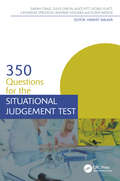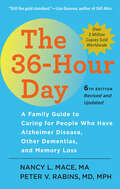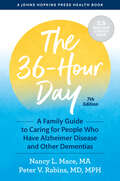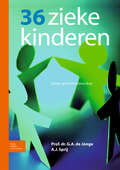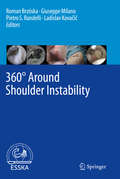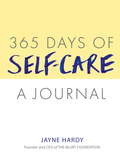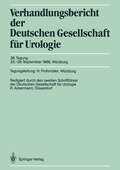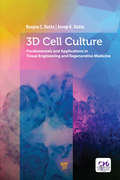- Table View
- List View
34th Hemophilia Symposium Hamburg 2003: HIV Infection and Epidemiology; Management of Bleedings in Hemophiliacs with Inhibitors;Orthopedic Problems and Therapy in Hemophiliacs;Therapy with Protein C;Pediatric Hemostaseology;Free Lectures
by I. Scharrer W. SchrammThis book contains the contributions to the 34th Hemophilia Symposium, Hamburg 2003. The main topics are HIV infection and epidemiology, management of bleedings in hemophiliacs with inhibitors, orthopedic problems and therapy in hemophiliacs, therapy with protein C and pediatric hemostaseology. The volume is rounded off by numerous free papers and posters on hemophilia, hemophiliacs with inhibitors, thrombophilia and molecular diagnostics.
350 Questions for the Situational Judgement Test (Medical Finals Revision Series)
by Sarah Craig Giles Dixon Alice Pitt Isobel Platt Catherine Sproson Andrew Viggars Eileen WedgeThis book presents over 350 ranking and multiple-choice questions, arranged by subject groups aligned with the domains of the SJT examination, and designed specifically to explore the readiness of candidates to face the scenarios that they will encounter as a junior doctor. A clear discussion of how the correct answer was reached and other options ruled out for every question is given at the end of each chapter, making this book an excellent learning aid through all stages of undergraduate studies, and particularly during revision for the SJT examination.
350 Questions for the Situational Judgement Test (Medical Finals Revision Series)
by Sarah Craig Giles Dixon Alice Pitt Isobel Platt Catherine Sproson Andrew Viggars Eileen WedgeThis book presents over 350 ranking and multiple-choice questions, arranged by subject groups aligned with the domains of the SJT examination, and designed specifically to explore the readiness of candidates to face the scenarios that they will encounter as a junior doctor. A clear discussion of how the correct answer was reached and other options ruled out for every question is given at the end of each chapter, making this book an excellent learning aid through all stages of undergraduate studies, and particularly during revision for the SJT examination.
35th Hemophilia Symposium Hamburg 2004: Epidemiology;Risk of Infections and Inhibitors in Hemophilia; Chronic lic Synovitis and Long-term Results of Orthopedic Treatment;Laboratory Diagnostics:Coagulation Factors; Inhibitors, Monitoring;Pediatric Hemostaseology;Free Lectures
by Inge Scharrer Wolfgang SchrammMotion analysis as introduced 2 years ago on a national basis effectively identifies individual functional disorders and provides a means for describing them on the basis of a score. Individual therapy planning is possible. More treatment tends to produce better function scores and thus helps to lower the strain on the joint. Further study is required in order to determine whether this reduces the incidence of bleeding. Knee function is age-dependent. Height, weight and sporting activity seem to be influencing factors.Demeanor,pain,fatigue and parental motivation do not seem to have an impact. The roll-and-glide pattern is not age-dependent and probably shows functional abnormalities of the knee.Functional benchmarking of the sites is possible but d- ficult because each site selects the children differently.Age differences also render an overall assessment difficult. Some sites performed negative screening so as to only test children with more severe problems,while other sites performed no such selection.In other sites,the only children to show up for motion analysis were those with well informed parents and who are always involved in all the other activities on offer too.
The 36-Hour Day: A Family Guide to Caring for People Who Have Alzheimer Disease, Other Dementias, and Memory Loss (A Johns Hopkins Press Health Book)
by Nancy L. Mace Peter V. RabinsThrough five editions, The 36-Hour Day has been an essential resource for families who love and care for people with Alzheimer disease. Whether a person has Alzheimer disease or another form of dementia, he or she will face a host of problems. The 36-Hour Day will help family members and caregivers address these challenges and simultaneously cope with their own emotions and needs.Featuring useful takeaway messages and informed by recent research into the causes of and the search for therapies to prevent or cure dementia, this edition includes new information on• devices to make life simpler and safer for people who have dementia• strategies for delaying behavioral and neuropsychiatric symptoms• changes in Medicare and other health care insurance laws• palliative care, hospice care, durable power of attorney, and guardianship• dementia due to traumatic brain injury• choosing a residential care facility• support groups for caregivers, friends, and family membersThe central idea underlying the bookâ€�that much can be done to improve the lives of people with dementia and of those caring for themâ€�remains the same. The 36-Hour Day is the definitive dementia care guide.
The 36-Hour Day: A Family Guide to Caring for People Who Have Alzheimer Disease, Other Dementias, and Memory Loss (A Johns Hopkins Press Health Book)
by Nancy L. Mace Peter V. RabinsThrough five editions, The 36-Hour Day has been an essential resource for families who love and care for people with Alzheimer disease. Whether a person has Alzheimer disease or another form of dementia, he or she will face a host of problems. The 36-Hour Day will help family members and caregivers address these challenges and simultaneously cope with their own emotions and needs.Featuring useful takeaway messages and informed by recent research into the causes of and the search for therapies to prevent or cure dementia, this edition includes new information on• devices to make life simpler and safer for people who have dementia• strategies for delaying behavioral and neuropsychiatric symptoms• changes in Medicare and other health care insurance laws• palliative care, hospice care, durable power of attorney, and guardianship• dementia due to traumatic brain injury• choosing a residential care facility• support groups for caregivers, friends, and family membersThe central idea underlying the bookâ€�that much can be done to improve the lives of people with dementia and of those caring for themâ€�remains the same. The 36-Hour Day is the definitive dementia care guide.
The 36-Hour Day: A Family Guide to Caring for People Who Have Alzheimer Disease and Other Dementias (A Johns Hopkins Press Health Book)
by Nancy L. Mace Peter V. RabinsWith over 3.5 million copies sold, the bestselling guide to understanding and caring for people with dementia is now completely revised and updated!For 40 years, The 36-Hour Day has been the leading work in the field for caregivers of those with dementia. Written by experts with decades of experience caring for individuals with memory loss, Alzheimer's, and other dementias, the book is widely known for its authoritativeness and compassionate approach to care. Featuring everything from the causes of dementia to managing its early stages to advice on caring for those in the later stages of the disease, it is widely considered to be the most detailed and trusted book available. Highlighting useful takeaway messages and informed by recent research into the causes of dementia, this new edition has been completely updated. It features • brand-new content on everything from home care aides to useful apps to promising preventative techniques and therapies• practical advice for avoiding caregiver burnout—plus tips for when and how to get additional help• a completely new two-column design that allows readers to quickly access what they needThe central idea underlying this indispensable book—that much can be done to improve the lives of people with dementia and of those caring for them—remains the same. The 36-Hour Day is the definitive dementia care guide.
The 36-Hour Day: A Family Guide to Caring for People Who Have Alzheimer Disease and Other Dementias (A Johns Hopkins Press Health Book)
by Nancy L. Mace Peter V. RabinsWith over 3.5 million copies sold, the bestselling guide to understanding and caring for people with dementia is now completely revised and updated!For 40 years, The 36-Hour Day has been the leading work in the field for caregivers of those with dementia. Written by experts with decades of experience caring for individuals with memory loss, Alzheimer's, and other dementias, the book is widely known for its authoritativeness and compassionate approach to care. Featuring everything from the causes of dementia to managing its early stages to advice on caring for those in the later stages of the disease, it is widely considered to be the most detailed and trusted book available. Highlighting useful takeaway messages and informed by recent research into the causes of dementia, this new edition has been completely updated. It features • brand-new content on everything from home care aides to useful apps to promising preventative techniques and therapies• practical advice for avoiding caregiver burnout—plus tips for when and how to get additional help• a completely new two-column design that allows readers to quickly access what they needThe central idea underlying this indispensable book—that much can be done to improve the lives of people with dementia and of those caring for them—remains the same. The 36-Hour Day is the definitive dementia care guide.
36 zieke kinderen
by A. Sprij G.A. de JongeErvaring opdoen met echte patiënten is een essentieel onderdeel van iedere geneeskundige opleiding. In het contact met patiënten leert de co-assistent de theorie toe te passen en de problemen van de patiënt te herkennen en te formuleren. Maar er is altijd een tekort aan nieuwe 'echte' patiënten in de opleiding. 36 zieke kinderen is een papieren aanvulling op het aantal beschikbare echte patiënten.In dit boek leeft u zich in als arts betrokken bij kinderen. In dit boekje kunt u vragen bij uiteenlopende klachten, zoals acute diarree, congenitale heupdysplasie en schoolproblematiek beantwoorden, door de antwoorden te noteren zoals u dat zou doen in het patiëntendossier: kort en bondig, puntsgewijs en overzichtelijk. Na iedere patient kunt u uw antwoorden vergelijken met de suggesties van de auteurs. Uiteraard zijn er voor veel problemen geen standaardantwoorden. Soms zal zelfs doorverwijzing de beste optie zijn.Voor verdere studie en verdieping vindt u na elke bespreking een suggestie voor nadere literatuur.Deze derde druk van 36 zieke kinderen is bedoeld voor co-assistenten en basisartsen.
360° Around Shoulder Instability
by Roman Brzóska Giuseppe Milano Pietro S. Randelli Ladislav KovačičThis book presents the current status of shoulder instability treatment with the aim of equipping readers with a comprehensive understanding of the latest concepts of shoulder instability, diagnosis and the decision-making process, conservative treatment, state of the art surgical techniques, and management of treatment failures. Written by leading European and overseas specialists, the book merges the authors’ clinical experience with expert opinions and up-to-date research data to offer shoulder surgeons, physiotherapists, other shoulder practitioners, and residents strong support in everyday practice. The coverage encompasses such pathologies as ALPSA, SLAP, HAGL, and Bankart lesions, and readers will find clear descriptions of soft tissue management, arthroscopic and open stabilization techniques, and recently published bone transfer techniques. Not only is the book copiously illustrated, but it also includes case examples, further illustrations, and links to high-resolution videos of the newest shoulder stabilization techniques performed by globally renowned experts. 360° Around Shoulder Instability is published in cooperation with ESSKA-ESA and is based on the 2nd biennial ESSKA-ESA meeting of the same name.
365 Days of Self-Care: A Journal
by Jayne HardyIt's one thing to understand how important self-care is, but how many of us actually manage to make the time do it?In 365 Days of Self-Care, CEO and founder of The Blurt Foundation, Jayne Hardy encourages you to take some time each and every day to be mindful, to check-in and prioritise the things that are truly important to you. This ebook edition contains: 365 daily prompts and trackers to note your moods, sleep and more; thoughtful mini-essays to prompt some deeper work; and check-in pages to help you see your progress - everything you need to get started on your self-care journey. Examples of daily prompts include:· Day 1: Boost· Day 52: Appreciate· Day 142: Rebel· Day 209: Thankful· Day 327: CourageWith the flexibility of choosing to start the journal anytime; on any day, in any year, this is the essential companion for bringing more self-care into your life.
36th Hemophilia Symposium Hamburg 2005: Epidemiology; Hemophilia Therapy - Management of Bleedings and Inhibitors; Orthopedic Treatment in Hemophiliacs; Hemostaseologic Diagnosis; Pediatric Hemostaseology; Free Lectures
by G. Auerswald A. Kurth J. Oldenburg W. Schramm B. Zieger37th Hemophilia Symposium Hamburg 2006: Epidemiology;Treatment of Inhibitors in Hemophiliacs; Hemophilic Arthropathy and Synovitis; Relevant Hemophilia Treatment 2006; Pediatric Hemostasiology; Free Lectures
by I. Scharrer Wolfgang SchrammThis book contains the contribution to the 37th Hemophilia Symposium, Hamburg 2006. The main topics are epidemiolgy, treatment of inhibitors in hemophiliacs, hemophilic arthropathy and synovitis, relevant hemophilia treatment 2006, and pediatric hemostasiology. The volume is rounded off by numerous free papers and posters on hemophilia, casuistics, and diagnostics.
38. Tagung, 23.–28. September 1986, Würzburg (Verhandlungsbericht der Deutschen Gesellschaft für Urologie #38)
by Rolf Ackermann Hubert FrohmüllerDieser Band enthält die Vorträge anläßlich der 38. Tagung der Deutschen Gesellschaft für Urologie in Würzburg. Die Hauptthemen behandeln die Lymphknotenchirugie bei urologischen Tumoren und das Prostatakarzinom sowie Fragen der Nierentransplantation.
3D & 4D Printing Methods for Pharmaceutical Manufacturing and Personalised Drug Delivery: Opportunities and Challenges (AAPS Introductions in the Pharmaceutical Sciences #11)
by Dimitrios A. LamprouNew materials and manufacturing techniques are emerging with potential to address the challenges associated with the manufacture of pharmaceutical systems that will teach new tricks to old drugs. 3D printing (3DP) is a technique that can used for the manufacturing of dosage forms, and especially targeting paediatric and geriatric formulations, as permits the fabrication of high degrees of complexity with great reproducibility, in a fast and cost-effective fashion, and offers a new paradigm for the direct manufacture of personalised dosage forms. The book is covering the basics behind each additive manufacturing (AM) method, current applications in pharmaceutics for each 3DP method, and case studies (examples) from a teaching perspective, targeting undergraduate (UG) and postgraduate (PG) students. A unique to this book is the integration of studies based upon the use of different AM technologies, which designed to reinforce importance printing parameters and material considerations. The book includes case studies or multiple-choice questions (MCQs), which allow application of the content in a flipped-classroom.
3D Analysis of the Myocardial Microstructure: Determination of Fiber and Sheet Orientations (BestMasters)
by Johanna Maria TicarThe master thesis of Johanna Maria Ticar reveals high-resolution insights into the myocardial microstructure and illustrates that cardiac muscle fibers are straight, running in parallel with one preferred fiber direction, however, deposits such as fat seem to compromise the regular and compact structure. Second harmonic generation imaging combined with optical tissue clearing is an accurate method for determining the three-dimensional muscle fiber and sheet orientations and hence, allows the calculation of fiber rotation throughout the ventricle wall.
3D Automated Breast Volume Sonography: A Practical Guide
by Veronika GazhonovaThis book introduces an exciting new method for breast ultrasound diagnostics – automated whole-breast volume scanning (3D ABVS). Scanning technique is described in detail, with guidance on scanning positions and protocols. Imaging findings are then illustrated and discussed for normal breast variants, the different forms of breast cancer, fibroadenomas, cystic disease, benign and malignant male breast disorders, mastitis, breast implants, and postoperative breast scars. In order to aid appreciation of the benefits of 3D ABVS, comparisons with findings on X-ray mammography and conventional 2D hand-held US are presented. Readers will be especially impressed by the convincing demonstration of the advantages of the new method for diagnosis of breast cancer in women with dense glandular tissue. In enabling readers to learn how to perform and interpret 3D ABVS, this book will be of great value for all who are embarking on its use. It will also serve as a welcome reference for radiologists, oncologists, and ultrasonographers who already have some familiarity with the technique.
3D Bioprinting: Modeling In Vitro Tissues and Organs Using Tissue-Specific Bioinks
by Dong-Woo Cho Byoung Soo Kim Jinah Jang Ge Gao Wonil Han Narendra K. SinghThis text advances fundamental knowledge in modeling in vitro tissues/organs as an alternative to 2D cell culture and animal testing. Prior to engineering in vitro tissues/organs,the descriptions of prerequisites (from pre-processing to post-processing) in modeling in vitro tissues/organs are discussed. The most prevalent technologies that have been widely used for establishing the in vitro tissue/organ models are also described, including transwell, cell spheroids/sheets, organoids, and microfluidic-based chips. In particular, the authors focus on 3D bioprinting in vitro tissue/organ models using tissue-specific bioinks. Several representative bioprinting methods and conventional bioinks are introduced. As a bioink source, decellularized extracellular matrix (dECM) are importantly covered, including decellularization methods, evaluation methods for demonstrating successful decellularization, and material safety. Taken together, the authors delineate various application examples of 3D bioprinted in vitro tissue/organ models especially using dECM bioinks.
3D Bioprinting in Medicine: Technologies, Bioinks, and Applications
by Murat GuvendirenThis book provides current and emerging developments in bioprinting with respect to bioprinting technologies, bioinks, applications, and regulatory pathways. Topics covered include 3D bioprinting technologies, materials such as bioinks and bioink design, applications of bioprinting complex tissues, tissue and disease models, vasculature, and musculoskeletal tissue. The final chapter is devoted to clinical applications of bioprinting, including the safety, ethical, and regulatory aspects. This book serves as a go-to reference on bioprinting and is ideal for students, researchers and professionals, including those in academia, government, the medical industry, and healthcare.
3D Bioprinting in Regenerative Engineering: Principles and Applications (CRC Press Series In Regenerative Engineering)
by Ali Khademhosseini Gulden Camci-UnalRegenerative engineering is the convergence of developmental biology, stem cell science and engineering, materials science, and clinical translation to provide tissue patches or constructs for diseased or damaged organs. Various methods have been introduced to create tissue constructs with clinically relevant dimensions. Among such methods, 3D bioprinting provides the versatility, speed and control over location and dimensions of the deposited structures. Three-dimensional bioprinting has leveraged the momentum in printing and tissue engineering technologies and has emerged as a versatile method of fabricating tissue blocks and patches. The flexibility of the system lies in the fact that numerous biomaterials encapsulated with living cells can be printed. This book contains an extensive collection of papers by world-renowned experts in 3D bioprinting. In addition to providing entry-level knowledge about bioprinting, the authors delve into the latest advances in this technology. Furthermore, details are included about the different technologies used in bioprinting. In addition to the equipment for bioprinting, the book also describes the different biomaterials and cells used in these approaches. This text: Presents the principles and applications of bioprinting Discusses bioinks for 3D printing Explores applications of extrusion bioprinting, including past, present, and future challenges Includes discussion on 4D Bioprinting in terms of mechanisms and applications
3D Bioprinting in Regenerative Engineering: Principles and Applications (CRC Press Series In Regenerative Engineering)
by Ali Khademhosseini Gulden Camci-UnalRegenerative engineering is the convergence of developmental biology, stem cell science and engineering, materials science, and clinical translation to provide tissue patches or constructs for diseased or damaged organs. Various methods have been introduced to create tissue constructs with clinically relevant dimensions. Among such methods, 3D bioprinting provides the versatility, speed and control over location and dimensions of the deposited structures. Three-dimensional bioprinting has leveraged the momentum in printing and tissue engineering technologies and has emerged as a versatile method of fabricating tissue blocks and patches. The flexibility of the system lies in the fact that numerous biomaterials encapsulated with living cells can be printed. This book contains an extensive collection of papers by world-renowned experts in 3D bioprinting. In addition to providing entry-level knowledge about bioprinting, the authors delve into the latest advances in this technology. Furthermore, details are included about the different technologies used in bioprinting. In addition to the equipment for bioprinting, the book also describes the different biomaterials and cells used in these approaches. This text: Presents the principles and applications of bioprinting Discusses bioinks for 3D printing Explores applications of extrusion bioprinting, including past, present, and future challenges Includes discussion on 4D Bioprinting in terms of mechanisms and applications
3D Cell-Based Biosensors in Drug Discovery Programs: Microtissue Engineering for High Throughput Screening
by William S. KisaalitaAdvances in genomics and combinatorial chemistry during the past two decades inspired innovative technologies and changes in the discovery and pre-clinical development paradigm with the goal of accelerating the process of bringing therapeutic drugs to market. Written by William Kisaalita, one of the foremost experts in this field, 3D Cell-Based Bio
3D Cell Culture: Fundamentals and Applications in Tissue Engineering and Regenerative Medicine
by Ranjna C. Dutta Aroop K. Dutta3D cell culture is yet to be adopted and exploited to its full potential. It promises to upgrade and bring our understanding about human physiology to the highest level with the scope of applying the knowledge for better diagnosis as well as therapeutics. The focus of this book is on the direct impact of novel technologies and their evolution into viable products for the benefit of human race. It also describes the fundamentals of cell microenvironment to bring forth the relevance of 3D cell culture in tissue engineering and regenerative medicine. It discusses the extracellular matrix/microenvironment (ECM) and emphasizes its significance for growing cells in 3D to accomplish physiologically viable cell mass/tissue ex vivo. The book bridges the knowledge gaps between medical need and the technological applications through illustrations. It discusses the available models for 3D cell culture as well as the techniques to create substrates and scaffolds for achieving desired 3D microenvironment.
3D Cell Culture: Fundamentals and Applications in Tissue Engineering and Regenerative Medicine
by Ranjna C. Dutta Aroop K. Dutta3D cell culture is yet to be adopted and exploited to its full potential. It promises to upgrade and bring our understanding about human physiology to the highest level with the scope of applying the knowledge for better diagnosis as well as therapeutics. The focus of this book is on the direct impact of novel technologies and their evolution into viable products for the benefit of human race. It also describes the fundamentals of cell microenvironment to bring forth the relevance of 3D cell culture in tissue engineering and regenerative medicine. It discusses the extracellular matrix/microenvironment (ECM) and emphasizes its significance for growing cells in 3D to accomplish physiologically viable cell mass/tissue ex vivo. The book bridges the knowledge gaps between medical need and the technological applications through illustrations. It discusses the available models for 3D cell culture as well as the techniques to create substrates and scaffolds for achieving desired 3D microenvironment.
3D Contrast MR Angiography
by Martin R. Prince Thomas M. Grist Jörg F. DebatinNon-invasive, high resolution contrast arteriography without arte rial catheterization or nephrotoxicity is now possible. It is accomplished by using paramagnetic contrast and an MR scanner. Paramagnetic contrast media is injected intravenously and image data are collected as the con trast circulates through the vascular territory of interest. Due to the strong enhancement effect of paramagnetic contrast media, a small dose injected as an intravenous bolus is sufficient to briefly enhance the entire arterial vascular tree. This allows imaging with a large field-of-view that encompasses an extensive region of vascular anatomy. By using a 3D gradient echo pulse sequence on magnets with high performance gra dient systems, high resolution 3D volumes of image data are acquired in a single breath-hold. This has vastly improved image quality of 3D con trast MRA exams, particularly in the chest and abdomen. Subsequent post-processing allows an angiographic display of image data in any desired obliquity. The success of this technique is reflected by its incorporation into clinical practice in centers throughout the world. It has been applied to multiple vascular territories, using various magnets, and slightly differ ing imaging strategies. As is the ca se for all MR imaging techniques, a thorough understanding of the underlying mechanisms and proper technique are essential to fully exploit the diagnostic potential of this new form of angiography. This book will familiarize the reader with the basic principles of 3D contrast MRA.

